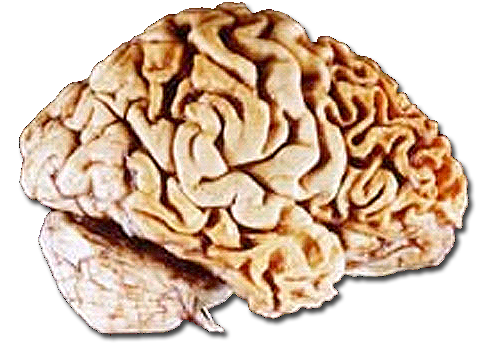Frontotemporal lobar degeneration
| Frontotemporal lobar degeneration | |
 | |
|---|---|
| A human brain showing frontotemporal lobar degeneration causing frontotemporal dementia. | |
| OMIM | 600274 |
| DiseasesDB | 10034 |
| MeSH | D003704 |
Please Take Over This Page and Apply to be Editor-In-Chief for this topic: There can be one or more than one Editor-In-Chief. You may also apply to be an Associate Editor-In-Chief of one of the subtopics below. Please mail us [1] to indicate your interest in serving either as an Editor-In-Chief of the entire topic or as an Associate Editor-In-Chief for a subtopic. Please be sure to attach your CV and or biographical sketch.
Overview
Frontotemporal lobar degeneration (FTLD) is a pathologic process involving degeneration of gray matter in the frontal lobe and anterior portion of the temporal lobe of the cerebrum, with sparing of the parietal and occipital lobes.
In the over 65 age group, FTLD is probably the fourth most common cause of dementia after Alzheimer's disease, Dementia with Lewy bodies and vascular dementia. In the below 65 age group, it is the second most common cause after Alzheimer's disease. The process of FTLD is thought to be the main cause of three clinical syndromes: frontotemporal dementia, semantic dementia, and progressive nonfluent aphasia.
The gross finding of frontotemporal lobar degeneration is likely produced by several etiologically distinct processes, with unique genetic and histopathological findings. Accordingly, there are a number of possible histopathological findings at post-mortem:
- tau inclusions (either with Pick bodies or without)
- ubiquitin positive (tau-negative) inclusions - in the majority of cases that have this type of pathology the ubiquitinated inclusions contain a protein called TDP-43. There are three subtypes of this type of pathology. Mackenzie et al (and subsequently Davidson et al) describe the following: type 1 with intranuclear inclusions; type 2 with neurites predominantly and type 3 with cytoplasmic inclusions predominantly. It should be noted that not all ubiquitin-positive, tau negative cases stain for TDP-43 e.g. the CHMP2B cases but also other cases.
- Dementia lacking distinctive histology (DLDH) - A rare and controversial entity - new analyses have allowed many cases to be reclassified into one of the positively-defined subgroups.
Many cases (possibly up to 50%) of FTLD are genetic rather than sporadic. Mutations in the Tau gene (on chromosome 17q21 - known as MAPT or Microtubule Associated Protein Tau) can cause FTLD and there are over 40 known mutations at present. A series of new mutations associated with FTLD has been recently described in the progranulin gene which is remarkably also on chromosome 17q21. Patients with progranulin mutations have type 1 TDP-43 positive, tau negative pathology at post-mortem. Progranulin is associated with tumorgenesis when overproduced, whereas the mutations seen in the progranulin gene associated with FTLD suggests a deficit in progranulin may be the problem. There are currently 2 other known genes that can cause FTLD: CHMP2B (on chromosome 3) which is associated with a behavioural syndrome (mainly in a large Jutland cohort); and VCP (valosin-containing protein, on chromosome 9) which is associated with the IBMPFD syndrome (inclusion body myopathy, Paget's disease and frontotemporal dementia). These 2 genes only account for a tiny proportion of cases. A locus on chromosome 9 is associated with FTD-MND (or FTD-ALS) i.e. frontotemporal dementia associated with motor neurone disease (or amyotrophic lateral sclerosis) - the hunt for this gene is currently the focus of a number of research labs around the world.
References
- Mackenzie IR, Baborie A, Pickering-Brown S, Plessis DD, Jaros E, Perry RH, Neary D, Snowden JS, Mann DM. Heterogeneity of ubiquitin pathology in frontotemporal lobar degeneration: classification and relation to clinical phenotype. Acta Neuropathol (Berl). 2006 Nov;112(5):539-49. Epub 2006 Sep 26.
- Davidson Y, Kelley T, Mackenzie IR, Pickering-Brown S, Du Plessis D, Neary D, Snowden JS, Mann DM. Ubiquitinated pathological lesions in frontotemporal lobar degeneration contain the TAR DNA-binding protein, TDP-43. Acta Neuropathol (Berl). 2007 Jan 12; [Epub ahead of print]
- Neary D, Snowden JS, Gustafson L, Passant U, Stuss D, Black S, Freedman M, Kertesz A, Robert PH, Albert M, Boone K, Miller BL, Cummings J, Benson DF. "Frontotemporal lobar degeneration: a consensus on clinical diagnostic criteria." 'Neurology' (1998) 51(6):1546-54. Available: [2]
- Pickering-Brown SM. The complex aetiology of frontotemporal lobar degeneration. Exp Neurol. 2007 Jul;206(1):1-10. Epub 2007 Mar 24.
See also